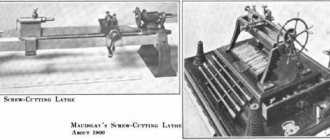It was long believed that the guillotine was invented in the late 18th century, however, recent research has shown that such "decapitation machines" have a longer history. The most famous, and perhaps one of the first, was a machine called the Halifax Gibbet, which was a monolithic wooden structure with two 15-foot posts topped by a horizontal beam. The blade was an ax that slid up and down along slots in the uprights.
Halifax Gallows. Source: wikipedia.org
Most likely, the creation of this “Halifax Gallows” dates back to 1066, although the first reliable mention of it dates back to the 1280s. Executions took place in the town's market square on Saturdays, and the machine remained in use until April 30, 1650.
A Profitable Nazi Endeavor
Guillotine of Nazi Germany.
The revival of the guillotine occurred during the Nazi period in Germany, when Hitler personally ordered the production of a large number of them. The executioners became quite rich people. One of the most famous executioners of Nazi Germany, Johan Reichhart, was able to buy himself a villa in a wealthy suburb of Munich with the money he earned.
The Nazis even managed to make additional profits from the families of beheaded victims. Each family was billed for each day the defendant was held in prison and an additional bill for the execution of the sentence. The guillotines were used for almost nine years, and 16,500 people were executed during this time.
Suicide
The guillotine is ready for use...
Despite the declining popularity of the guillotine, it continued to be used by those who decided to take their own lives. In 2003, 36-year-old Boyd Taylor from England spent several weeks constructing a guillotine in his bedroom that would turn on at night while he slept. His son's headless body was discovered by his father, who was awakened by a noise that sounded like a chimney falling from the roof.
In 2007, the body of a man was discovered in Michigan, killed in the forest by a mechanism he had built. But the worst thing was the death of David Moore. In 2006, Moore built a guillotine using metal conduit and a saw blade. However, the device initially did not work, leaving Moore only seriously injured. He had to get to the bedroom, where he had 10 Molotov cocktails hidden. Moore blew them up, but they didn't work as planned.
And if the guillotine was created for humane reasons and was designed to make it easier for a person to forcefully leave for another world, then the “Pear of Suffering” is an instrument of torture that forced people to admit to anything.
Famous guillotined individuals - Germans, Russians, Poles, Tatars
- Lubbe, Marinus van der - guillotined for burning down the Reichstag in January 1934.
- Stöbe, Ilse - guillotined in Berlin Plötzensee prison on December 22, 1942.
- Fucik, Julius - guillotined in Berlin Plötzensee prison on September 8, 1943.
- Obolenskaya, Vera Apollonovna - guillotined in Plötzensee prison on August 4, 1944.
— Jalil, Musa Mustafovich and his associates were guillotined for participation in an underground organization on August 25, 1944 in the Plötzensee military prison in Berlin.
— Klyachkovsky, Stanislav guillotined on charges of attempted assassination of Fuhrer Adolf Hitler, in Plötzensee prison on May 10, 1940.
Vietnam
Vietnamese guillotine.
In 1955, South Vietnam separated from North Vietnam, and the Republic of Vietnam was created, with Ngo Dinh Diem becoming its first president. Fearing coup plotters, he passed Law 10/59, under which anyone suspected of communist ties could be jailed without trial.
There, after terrible torture, a death sentence was eventually imposed. However, in order to fall victim to Ngo Dinh Diem, it was not necessary to go to prison. The ruler traveled through villages with a mobile guillotine and executed all those suspected of disloyalty. Over the next few years, hundreds of thousands of South Vietnamese were executed and their heads were hung everywhere.






